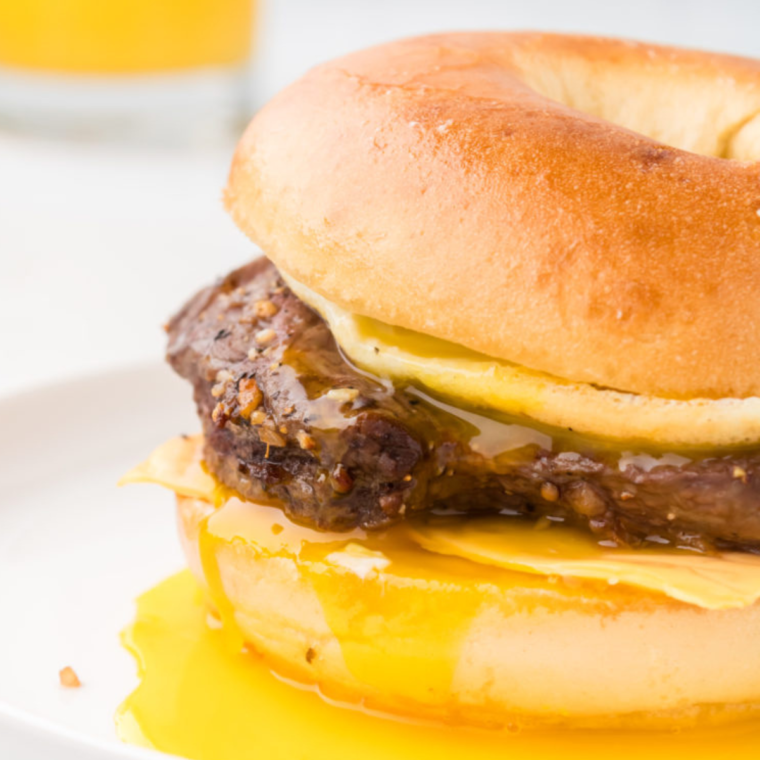Are Bagels Dairy Free? Hello, fellow food enthusiasts and health-conscious readers!
Today, we’re diving into a deliciously intriguing topic that has sparked curiosity and debate among many: Are bagels dairy-free? This question is particularly pertinent for those who are lactose intolerant, vegan, or simply looking to make more informed dietary choices.

With their chewy texture and versatility, bagels have been a breakfast staple and a snack favorite for years. But when it comes to understanding their ingredients, things can get a bit tricky, especially regarding the presence of dairy.
Today, we will explore:
- The Basic Ingredients of Bagels: What typically goes into making a bagel? We’ll break down the traditional components.
- Dairy and Non-Dairy Variations: Are there common bagel varieties that contain dairy? We’ll identify which types of bagels are more likely to be dairy-free and which ones to watch out for. Perfect if you have a milk allergy or are looking to avoid dairy.
- Understanding Labels and Ingredients: Learn how to read labels to spot hidden dairy ingredients and what to look for when purchasing or ordering bagels.
- Homemade Alternatives: For those interested in baking their own, we’ll touch on how to make dairy-free bagels at home.
- Navigating Restaurants and Bakeries: Tips on how to ask the right questions when you’re out and about to ensure your bagel is dairy-free.
Whether you’re a seasoned bagel lover or new to this culinary delight, understanding its ingredients is key to enjoying it in a way that aligns with your dietary needs and preferences. So, let’s get to the bottom of this and answer once and for all: Are bagels dairy-free? Stay tuned, and let’s embark on this doughy journey together!

What Are Bagels?
Bagels are a bread product known for their distinctive dense, chewy texture and ring-like shape. Originating from the Jewish communities in Poland, bagels have become a popular food item worldwide, particularly in the United States and Canada. They are often associated with New York City, famous for its bagel culture.
Key Characteristics of Bagels:
- Shape and Texture: Bagels are circular with a hole in the middle, similar to a doughnut. They are known for their dense and chewy texture, which sets them apart from other types of bread.
- Boiling Before Baking: A unique aspect of bagel preparation is that the dough is first boiled in water before it is baked. This boiling step is crucial as it contributes to the bagel’s signature texture and outer crust. The water can sometimes be sweetened or contain additives like malt, baking soda, or honey to influence the flavor and texture.
- Ingredients: Traditional bagel dough contains flour, water, yeast, salt, and sometimes a sweetener like malt syrup. They do not inherently contain dairy, making them suitable for lactose-intolerant individuals and vegans, depending on other ingredients and toppings.
- Varieties and Toppings: Bagels come in various flavors and types. Common varieties include plain, sesame, poppy seed, onion, garlic, cinnamon raisin, and bagels (topped with a mix of sesame seeds, poppy seeds, onion, garlic, and salt). They can be topped with a range of spreads, such as cream cheese, butter, or fruit jams, and can also be used to make sandwiches.
- Cultural and Historical Significance: Bagels have a rich cultural history deeply rooted in Jewish cuisine and tradition. They have been embraced by various cultures worldwide, adapting in flavor and form.
- Nutritional Value: Bagels are primarily a carbohydrate source. The nutritional content can vary based on the size and toppings, but they generally provide a good amount of energy and can contain some protein and micronutrients, depending on the flour and additives used.
Bagels are enjoyed in many ways, from a simple breakfast item to a base for elaborate sandwiches. Their versatility and unique texture make them a beloved food item for many around the globe.

What Are Bagels Made Of?
Bagels are made from a relatively simple dough composed of a few key ingredients. The traditional process of making bagels involves boiling and baking, giving them their characteristic chewy texture and shiny crust. Here’s a breakdown of the essential ingredients and the process involved:
Essential Ingredients of Bagel Dough:
- Flour: High-gluten flour, such as bread flour, is typically used for making bagels. The high gluten content helps create the chewy texture that bagels are famous for. Other options are almond flour, rice flour, or coconut flour.
- Water: Water is essential for forming the dough. The temperature and quantity of the water can affect the dough’s consistency and, subsequently, the texture of the bagels.
- Yeast: Instant Yeast is a key ingredient in bagel dough for leavening. It helps the dough rise and contributes to the development of flavor.
- Salt: Salt is added for flavor and also plays a role in strengthening the gluten network in the dough.
- Sweetener: Some sweetener, like malt syrup, barley malt powder, honey, or sugar, is often included in the dough. This adds a subtle sweetness and contributes to the browning of the crust during baking.
Optional Ingredients:
- Eggs: Some recipes might include eggs, although this is not traditional. Eggs can enrich the dough and affect the texture and color of the bagels.
- Oil or Fat: Occasionally, recipes may call for a small amount of oil or fat, making the dough a bit softer and affecting the mouthfeel.
- Flavorings and Additives: Various flavorings like cinnamon, raisins, onion, garlic, seeds (sesame, chocolate chip, or poppy seeds), or xanthan gum can be added to the dough or topping.

Making Bagels: The Process
- Mixing and Kneading: The ingredients are mixed and kneaded to form a stiff dough. This process develops the gluten, which is crucial for the texture.
- Rising: The dough is allowed to rise until it doubles in size. This fermentation step is essential for flavor development.
- Shaping: The dough is then divided and shaped into the classic bagel rings.
- Boiling: Before baking, bagels are boiled in warm water briefly. This step is unique to bagel making and gives them their distinctive chewy crust and interior. For extra flavor and texture, ingredients like malt extract, malt syrup, or baking soda are sometimes added to the boiling water.
- Baking: After boiling, the bagels are baked until golden brown. This creates a crispy exterior while maintaining a dense, chewy interior.
Understanding these ingredients and the process helps explain why bagels are distinct from other types of bread, with a unique texture and taste that have made them a beloved food item worldwide.

Are Bagels Dairy-Free?
Whether or not bagels are dairy-free depends on the specific recipe and the type of bagel. Traditionally, basic bagel dough, which includes flour, water, yeast, salt, and sometimes a sweetener like malt syrup, does not contain dairy. This means that many plain bagels would be considered dairy-free.
However, there are exceptions and variations to be aware of:
- Varieties with Dairy: Some bagel recipes and varieties include dairy ingredients. For instance, bagels with cheese toppings or flavors (like asiago or cheddar) contain dairy. Some recipes might also use milk instead of water for a more decadent dough or include butter, yogurt, or buttermilk.
- Commercial Bagels: Commercially produced bagels may have dairy or dairy derivatives, like those in supermarkets or certain bagel chains. These could be in the form of milk powders, whey, or butter. It’s always a good idea to check the ingredients list if you’re buying pre-packaged bagels.
- Cross-Contamination: For those with severe dairy allergies or strict dietary preferences (like vegans), it’s essential to consider the risk of cross-contamination. Even if a bagel does not contain dairy, it could be made or processed in a facility that handles dairy products.
- Toppings and Spreads: While the bagel might be dairy-free, common toppings like cream cheese, butter, or cheese are not. For an utterly dairy-free option, you would need to select non-dairy toppings.
Tips for Ensuring Bagels are Dairy-Free:
- Read Labels: Always read ingredient labels when purchasing pre-packaged bagels. Look for dairy terms like milk, butter, whey, casein, and lactose.
- Ask at Bakeries: If you’re buying from a bakery or bagel shop, don’t hesitate to ask staff about the ingredients. They can provide information on whether their bagels contain dairy or if there’s a risk of cross-contamination.
- Homemade Bagels: Making bagels at home allows you to control the ingredients, ensuring they are dairy-free.
- Look for Vegan Options: Bagels labeled as vegan will be dairy-free, as vegan products do not contain any animal-derived ingredients.
In summary, while many traditional bagel recipes are dairy-free, variations in ingredients and preparation methods can introduce dairy into the equation. It’s always best to check labels, ask questions, and consider dietary needs and sensitivities when selecting bagels.

Dairy-Free Bagel Options
Plenty of choices are available for those seeking dairy-free bagel options or following a dairy-free diet, whether due to lactose intolerance, a vegan diet, or other dietary preferences. Here’s a guide to finding and enjoying dairy-free bagels:
Commercial Dairy-Free Bagels
- Read Labels Carefully: Look for bagels labeled as dairy-free or vegan. Avoiding ingredients include almond milk, butter, whey, casein, and lactose.
- Brand Research: Some brands specialize in dairy-free or vegan products. Researching brands online or asking for forum recommendations can help you find reliable options.
- Organic and Health Food Stores: These stores often have a selection of dairy-free and vegan bread products, including bagels.
Bakery and Fresh Options
- Local Bakeries: Many local bakeries make bagels from scratch and can tell you precisely what’s in them. Ask if they have dairy-free and vegan bagels.
- Bagel Shops: Some specialty bagel shops offer dairy-free varieties. Don’t hesitate to inquire about ingredients and cross-contamination if you have allergies.
- Custom Orders: Some bakeries are willing to take custom orders for dairy-free bagels, especially if you plan to buy them regularly.
Homemade Bagels
- Making Your Own: Baking your own bagels can be a fun and rewarding way to ensure they are completely dairy-free. You’ll find many dairy-free bagel recipes online.
- Substitutes in Recipes: If a recipe calls for milk, substitute it with water or plant-based milk (like almond, soy, or oat). For recipes requiring butter, use dairy-free margarine or oils.
Dairy-Free Toppings and Spreads
- Plant-Based Cream Cheese: Many vegan and dairy-free cream cheese options are available, made from nuts (like cashews) or soy.
- Peanut Butter and Jams are naturally dairy-free and offer a sweet or savory bagel option.
- Avocado Spread: Mashed avocado with lemon juice, salt, and pepper makes a great dairy-free topping.
- Hummus: This chickpea-based spread is a flavorful, dairy-free option that pairs well with bagels.
- Vegetables and Dairy-Free Cheese: Fresh vegetables, baba ganoush, and dairy-free cheese slices can turn a bagel into a satisfying sandwich.
Eating Out and On-the-Go
- Ask Questions: Ask if they have dairy-free options when ordering bagels at a cafe or restaurant.
- Cross-Contamination: For those with severe allergies, inquire about the possibility of cross-contamination with dairy products.
You can enjoy bagels without worrying about dairy content by exploring these options. With the growing popularity of dairy-free and vegan diets, finding suitable bagel options in stores, bakeries, and even in many mainstream eateries is becoming more accessible.
Choosing the Right Bagel at Restaurants
Choosing the right bagel at a restaurant, especially if you have specific dietary requirements like being dairy-free or vegan, requires some know-how and sometimes some investigation. Here are some tips to help you select the right bagel when dining out:
1. Ask About Ingredients
- Dough Composition: Inquire if the bagel dough contains any dairy products (like milk, butter, or whey). Traditional bagel dough is usually dairy-free, but recipes can vary.
- Cross-Contamination: If you have a severe allergy, ask about potential cross-contamination with dairy products during preparation.
2. Understand Common Varieties
- Plain and Simple: Plain, sesame, poppy, onion, and garlic bagels are often safe bets. They are less likely to contain dairy compared to more elaborate varieties.
- Be Cautious with Flavored Bagels: Varieties like cheese, chocolate chip, or cinnamon-raisin might have dairy. Always confirm with the staff.
3. Look for Vegan Options
- Vegan-Friendly: If a bagel is labeled vegan, it will be dairy-free. Some restaurants might have special vegan or dairy-free- menu options or vegan-friendly items.
4. Check for Special Menus
- Dietary Menus: Some restaurants offer gluten-free, dairy-free, or other allergen-free menus. Ask if such options are available.
5. Consider Toppings and Spreads
- Dairy-Free Spreads: If the bagel itself is dairy-free, ensure your spreads and toppings are too. Opt for vegan cream cheese, plant-based butter, or fresh vegetables and fruit spreads.
6. Watch for Signs of Freshness
- Quality and Freshness: A good quality, fresh bagel can make a big difference in taste. This isn’t directly related to being dairy-free, but it enhances the overall experience.
7. Research Ahead of Time
- Online Menus: Check the restaurant’s menu online before visiting. Some may list ingredients or mark items as dairy-free or vegan.
- Reviews and Recommendations: Review reviews or forums where others might have shared their dairy-free experiences at the restaurant. Dairy-free alternatives are always at grocery stores and select bagel restaurants.
8. Communicate Your Needs Clearly
- Allergies and Preferences: Be clear about your dietary requirements. If you have a dairy allergy, it’s essential to communicate that it’s an allergy rather than a preference, as this often warrants extra precautions in the kitchen.
9. When in Doubt, Skip It
- If you’re unsure and can’t get reliable information about the bagel’s ingredients, choosing another item or eating elsewhere is safer, especially if you have allergies.
By taking these steps, you can enjoy a delicious bagel experience at restaurants while adhering to your dietary needs. Remember, most staff are willing to help and provide information,





